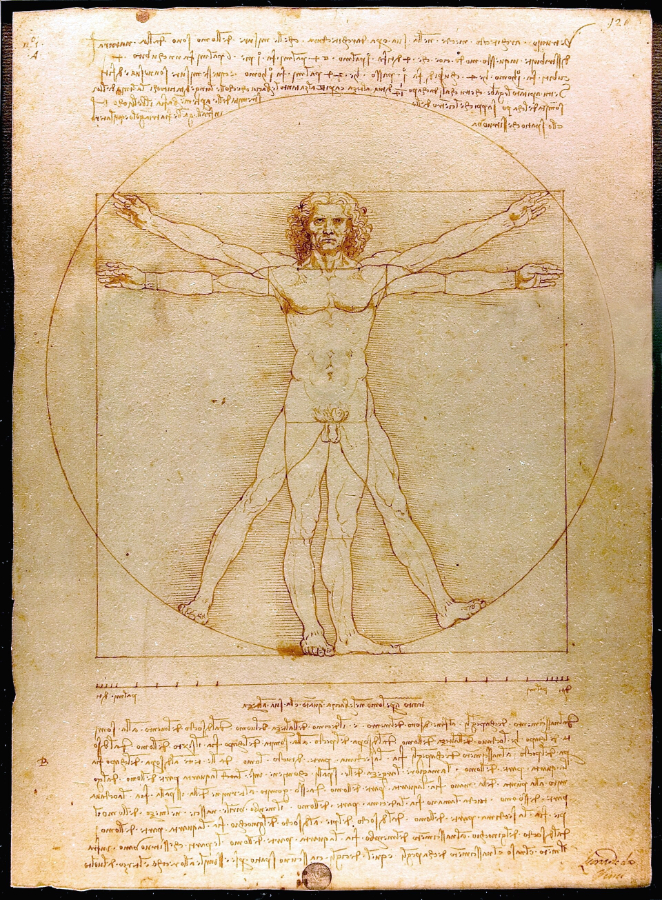The Vitruvian Man is a drawing by the Italian Renaissance artist and scientist Leonardo da Vinci, dated to c. 1490. Inspired by the writings of the ancient Roman architect Vitruvius, the drawing depicts a nude man in two superimposed positions with his arms and legs apart and inscribed in both a circle and square. It was described by the art historian Carmen C. Bambach as “justly ranked among the all-time iconic images of Western civilization”. Although not the only known drawing of a man inspired by the writings of Vitruvius, the work is a unique synthesis of artistic and scientific ideals and often considered an archetypal representation of the High Renaissance. The drawing represents Leonardo’s conception of ideal body proportions, originally derived from Vitruvius but influenced by his own measurements, the drawings of his contemporaries, and the De pictura treatise by Leon Battista Alberti. Leonardo produced the Vitruvian Man in Milan and the work was probably passed to his student Francesco Melzi. It later came into the possession of Venanzio de Pagave, who convinced the engraver Carlo Giuseppe Gerli to include it in a book of Leonardo’s drawings, which widely disseminated the previously little-known image. It was later owned by Giuseppe Bossi, who wrote early scholarship on it, and eventually sold to the Gallerie dell’Accademia of Venice in 1822, where it has remained since. Due to its sensitivity to light, the drawing rarely goes on public display, but it was borrowed by the Louvre in 2019 for their exhibition marking the 500th anniversary of Leonardo’s death.
| Alias The Vitruvian Man |
| Real Names/Alt Names N/A |
| Characteristics The Renaissance |
| Creators/Key Contributors Leonardo da Vinci |
| First Appearance Drawing by Leonardo da Vinci (1490s) |
| First Publisher ○ |
| Appearance List Di Lucio Vitruvio Pollione De architectura libri dece (1521) by Vitruvius — trans. & illus. Cesare Cesariano; I dieci libri dell’architettvra (1556) by Vitruvius — ed. Daniele Barbaro (with illustrations in the Vitruvian tradition); Disegni di Leonardo da Vinci incisi e pubblicati da Carlo Giuseppe Gerli (1784) by Carlo Giuseppe Gerli (after Leonardo da Vinci) — first wide publication of Leonardo’s drawing(s); Delle opinioni di Leonardo da Vinci intorno alla simmetria de’ corpi umani (1811) by Giuseppe Bossi — early study on Leonardo’s human-proportion theory; The Ten Books on Architecture (1914) by Vitruvius — trans. Morris H. Morgan (standard English reference for the proportional text); The Notebooks of Leonardo da Vinci (1938) by Leonardo da Vinci — ed. Edward MacCurdy; includes “Proportions of the Human Body according to Vitruvius”; Architectural Principles in the Age of Humanism (1949) by Rudolf Wittkower — account of Renaissance proportion theory; Leonardo da Vinci (1952) by Kenneth Clark — classic monograph with analysis and reproductions of Leonardo’s proportion studies. |
| Sample Read The Ten Books on Architecture (1914) by Vitruvius [Internet Archive] |
| Description The Vitruvian Man is a drawing by the Italian Renaissance artist and scientist Leonardo da Vinci, dated to c. 1490. Inspired by the writings of the ancient Roman architect Vitruvius, the drawing depicts a nude man in two superimposed positions with his arms and legs apart and inscribed in both a circle and square. It was described by the art historian Carmen C. Bambach as “justly ranked among the all-time iconic images of Western civilization”. Although not the only known drawing of a man inspired by the writings of Vitruvius, the work is a unique synthesis of artistic and scientific ideals and often considered an archetypal representation of the High Renaissance. The drawing represents Leonardo’s conception of ideal body proportions, originally derived from Vitruvius but influenced by his own measurements, the drawings of his contemporaries, and the De pictura treatise by Leon Battista Alberti. Leonardo produced the Vitruvian Man in Milan and the work was probably passed to his student Francesco Melzi. It later came into the possession of Venanzio de Pagave, who convinced the engraver Carlo Giuseppe Gerli to include it in a book of Leonardo’s drawings, which widely disseminated the previously little-known image. It was later owned by Giuseppe Bossi, who wrote early scholarship on it, and eventually sold to the Gallerie dell’Accademia of Venice in 1822, where it has remained since. Due to its sensitivity to light, the drawing rarely goes on public display, but it was borrowed by the Louvre in 2019 for their exhibition marking the 500th anniversary of Leonardo’s death. |
| Source Vitruvian Man – Wikipedia |

